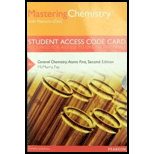
(a)
Interpretation:
The given semiconductor has to be classified as n-type or p-type semiconductor.
Concept introduction:
Semiconductor:
A material which can conduct electricity in range between a metal and an insulator is known as semiconductor. Addition of small amount of impurities increases conductivity of semiconductor and the process is known as doping. n-type and p-type are two types of doped semiconductors.
p-type semiconductor:
p-type doped semiconductor is the one in which holes (positive charge) are present in valence band. Example: silicon doped with boron.
n-type semiconductor:
This type of doped semiconductor is the one in which many free electrons are present in conduction band.
(b)
Interpretation:
The given semiconductor has to be classified as n-type or p-type semiconductor.
Concept introduction:
Semiconductor:
A material which can conduct electricity in range between a metal and an insulator is known as semiconductor. Addition of small amount of impurities increases conductivity of semiconductor and the process is known as doping. n-type and p-type are two types of doped semiconductors.
p-type semiconductor:
p-type doped semiconductor is the one in which holes (positive charge) are present in valence band. Example: silicon doped with boron.
n-type semiconductor:
This type of doped semiconductor is the one in which many free electrons are present in conduction band.
(c)
Interpretation:
The given semiconductor has to be classified as n-type or p-type semiconductor.
Concept introduction:
Semiconductor:
A material which can conduct electricity in range between a metal and an insulator is known as semiconductor. Addition of small amount of impurities increases conductivity of semiconductor and the process is known as doping. n-type and p-type are two types of doped semiconductors.
p-type semiconductor:
p-type doped semiconductor is the one in which holes (positive charge) are present in valence band. Example: silicon doped with boron.
n-type semiconductor:
This type of doped semiconductor is the one in which many free electrons are present in conduction band.
Want to see the full answer?
Check out a sample textbook solution
Chapter 21 Solutions
Masteringchemistry with Pearson Etext -- Standalone Access Code Card -- For General Chemistry
- 8.96 A business manager wants to provide a wider range of p- and n-type semiconductors as a strategy to enhance sales. You are the lead materials engineer assigned to communicate with this manager. How would you explain why there are more ways to build a p-type semiconductor from silicon than there are ways to build an n-type semiconductor from silicon?arrow_forward7 Describe the theory behind:- a) Precipitation Age Hardening of Aluminum alloys b) Hardenability of steels Give diagrams as well in each case.arrow_forwardPredict the structure of each of the following silicate minerals (network, sheets, double chains, and so forth). Give the oxidation state of each atom.(a) Apophyllite, KCa4(Si8O20)F ? 8 H2O(b) Rhodonite, CaMn4(Si5O15)(c) Margarite, CaAl2(Al2Si2O10)(OH)2arrow_forward
- (a) Why electrical conductivity of the semiconductor increases with increase in temperature? Illustrate and explain the above effect with hypothetical band energy diagrams, showing one at 25 °C and another at 50 °C? (b) The number average molecular weight of polyvinyl chloride (PVC) is 110000 g/mol and the Polydispersity index (PDI) is 1.3. What is the weight average molecular weight and degree of polymerization of PVC? Note: Molar mass of vinyl chloride is 62.498 g/molarrow_forwardDefine the following:(i) F-centre (ii) p-type semiconductor(iii) Ferrimagnetism.arrow_forward
 Principles of Modern ChemistryChemistryISBN:9781305079113Author:David W. Oxtoby, H. Pat Gillis, Laurie J. ButlerPublisher:Cengage Learning
Principles of Modern ChemistryChemistryISBN:9781305079113Author:David W. Oxtoby, H. Pat Gillis, Laurie J. ButlerPublisher:Cengage Learning Chemistry for Engineering StudentsChemistryISBN:9781337398909Author:Lawrence S. Brown, Tom HolmePublisher:Cengage Learning
Chemistry for Engineering StudentsChemistryISBN:9781337398909Author:Lawrence S. Brown, Tom HolmePublisher:Cengage Learning Physical ChemistryChemistryISBN:9781133958437Author:Ball, David W. (david Warren), BAER, TomasPublisher:Wadsworth Cengage Learning,
Physical ChemistryChemistryISBN:9781133958437Author:Ball, David W. (david Warren), BAER, TomasPublisher:Wadsworth Cengage Learning, Chemistry: Principles and PracticeChemistryISBN:9780534420123Author:Daniel L. Reger, Scott R. Goode, David W. Ball, Edward MercerPublisher:Cengage Learning
Chemistry: Principles and PracticeChemistryISBN:9780534420123Author:Daniel L. Reger, Scott R. Goode, David W. Ball, Edward MercerPublisher:Cengage Learning
 Chemistry: An Atoms First ApproachChemistryISBN:9781305079243Author:Steven S. Zumdahl, Susan A. ZumdahlPublisher:Cengage Learning
Chemistry: An Atoms First ApproachChemistryISBN:9781305079243Author:Steven S. Zumdahl, Susan A. ZumdahlPublisher:Cengage Learning





